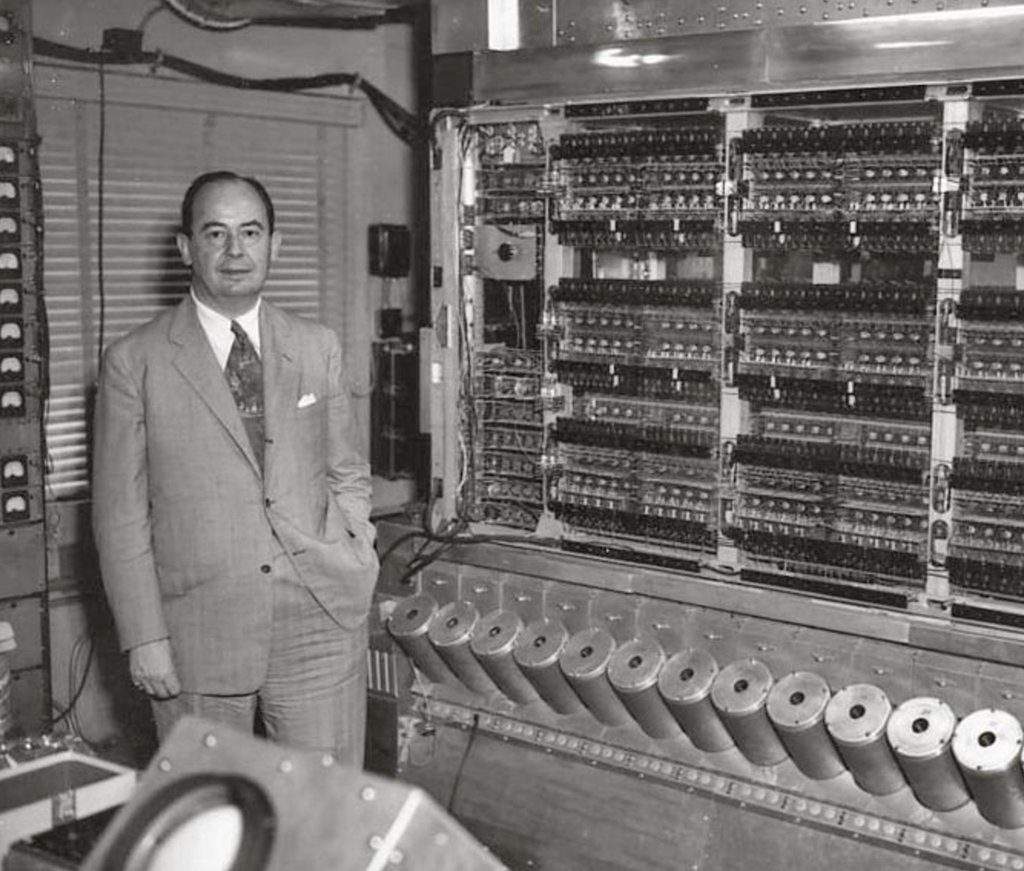John von Neumann, the father of modern computers

János Neumann was a Hungarian mathematician of Jewish origin. Born on the 28th of December, in 1903, he was the first child of a noble family. The father, Miksa was granted the hereditary title “margittai”, which János proudly used, before changing his name to Johann von Neumann, then John von Neumann, as he had become famous worldwide.
His family regarded János as a wonder child before the age of ten. The little John could joke in classical Greek and could quickly memorise a page from a telephone book and recite its numbers and addresses. He attended the “Fasori” Lutheran Secondary School, then, in 1921, he enrolled in the Budapest Science University’s Faculty of Mathematics. He often stayed in Berlin during his university years.
Here he had the opportunity to learn actuary mechanics from Einstein (he was not the only Hungarian student of the physicist genius) and maths for Erhardt Schmidt.
Photo: Wikicommons by LANL
He also made close connections with Wigner, Leo Szilárd and Dénes Gábor. In 1923, he started studying chemistry in Zurich, on his father’s request. He received his chemical engineering degree in 1925, and a year later, he finished the doctoral studies of mathematics in Budapest.
In 1928 von Neumann published “Theory of Parlor Games”, a critical paper in the field of game theory. The game of poker was its nominal inspiration. His game theory publication focuses on the element of bluffing. In games like poker, the optimal strategy incorporates a chance element. Poker players must occasionally bluff—and unpredictably— to avoid exploitation by a savvier player.
He was invited to Princeton in 1930 as a visiting professor. He soon became a professor of the university, then of the Institute for Advanced Studies, though he was known as a mediocre teacher: he would write too quickly and then erase the blackboard before students could have finished copying. When he was no longer teaching, he became a Princeton legend.
It was spread that he would play practical jokes at Einstein, could recite books he had read years ago word-for-word, and he could edit assembly-language computer code in his head.
War
During WWII, he took part in military technical research, just like many other scientists.
He began working on the Manhattan Project at the invitation of Oppenheimer.
At Los Alamos, New Mexico, von Neumann worked on Seth Neddermeyer’s implosion design for an atomic bomb. After the war, he also promoted the idea of the hydrogen bomb. From 1954 until 1956, von Neumann served as a member of the Atomic Energy Commission and was an architect of the policy of nuclear deterrence developed by President Dwight D. Eisenhower’s administration.
Computer sciences
In the postwar years, he contributed important ideas to the U.S. Army’s hard-wired ENIAC computer. Most importantly, von Neumann modified ENIAC to run as a stored-program machine. He then lobbied to build an improved computer at the Institute for Advanced Study.
The IAS machine, which began operating in 1951, used binary arithmetic
—ENIAC had used decimal numbers—and shared the same memory for code and data, a design that made subsequent coding much more accessible.

Weather systems and global warming
Neumann’s team performed the world’s first numerical weather forecasts on the ENIAC computer. Von Neumann’s interest in weather systems and meteorological prediction led him to
propose manipulating the environment by spreading colorants on the polar ice caps to enhance absorption of solar radiation, thereby inducing global warming.
He was the scientist who proposed the idea of global warming, noting that the burning of coal and oil would result in “general warming of the Earth by about one degree Fahrenheit.”
Death
In 1955, Neumann was diagnosed with bone or pancreatic cancer. The shadow of death filled him with fear and sorrow. “So long as there is the possibility of eternal damnation for nonbelievers it is more logical to be a believer at the end,” he repeatedly professed, and invited a Roman Catholic priest, Father Anselm Strittmatter, O.S.B., to visit him for consultation.
On his deathbed, he entertained his brother by reciting verbatim Goethe’s Faust.
He died at age 53 on February 8, 1957, under military security lest he reveals military secrets while heavily medicated. He was buried at Princeton Cemetery in Princeton, Mercer County, New Jersey.
Legacy
Many awards are named in his honour, such as the John von Neumann Theory Prize of the Institute for Operations Research and the Management Sciences, the IEEE John von Neumann Medal is awarded annually by the Institute of Electrical and Electronics Engineers and a crated of the moon is named von Neumann.
Featured Image: www.famous-mathematicians.com/john-von-neumann/
Source: britannica.com





